Photos by Lloyd Horgan
Italy’s boot-shaped peninsula juts out into the Mediterranean Sea like a massive, 560-mile (900-kilometer) jetty. For over 1,500 years it has allowed direct access into Europe from North Africa and the Levant to anything that would float.
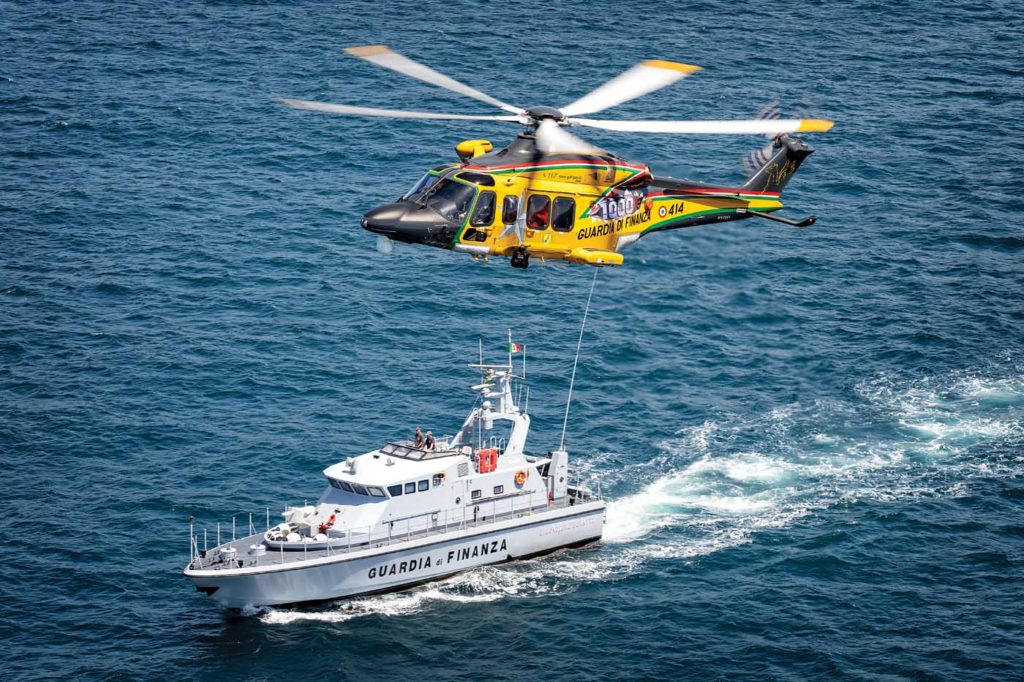
As such a prominent alighting point from the Mediterranean, Italy has become not only prosperous but also vitally important to European trade. However, increasingly technical and globalized crime has also made the country strategically important to security on the continent, demanding a greater emphasis than ever on control of the sea and the ability to work in partnership with nations far beyond the Italian border.
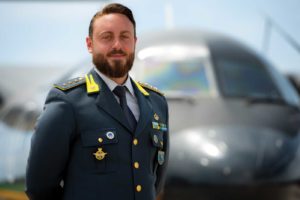
“Our role is to prevent illegal trafficking coming from the sea, generally speaking,” explained Capt. Paolo Pascale, deputy head of operations for the Comando Operativo AeroNavale (COAN, or aeronaval operational command) of the Guardia di Finanza, based at Pratica di Mare, near Rome.
Pascale’s position is testament to the economic threat posed by illegal trafficking. While it is a militarized law enforcement agency, the Guardia di Finanza falls under the authority of the Ministry of Economy and Finance, rather than the defense or interior ministries.
For an arm of what is effectively the treasury, the task of controlling the 4,700 miles (7,600 kilometers) of coastline might be intimidating, but the Guardia di Finanza is well-equipped.
Formidable fleet
“Here at Pratica di Mare we have the Gruppo Esplorazione Aeromarittima [abbreviated to GEA, meaning air/maritime exploration group] and we have a huge fleet at our disposal,” said Pascale.
That fleet includes all of the Guardia di Finanza’s fixed-wing aircraft. Piaggio P.180 and older Piaggio fulfill personnel transport and deployed surveillance roles, while four ATR-42MP aircraft provide longer-range and more specialist maritime patrol capability. GDF’s newest additions, two ATR-72MP maritime patrol aircraft, were delivered in 2019 and represent its most capable surveillance assets, with a multitude of sensors and communications equipment. Two more are expected to be delivered by 2022.
Alongside the GEA, the COAN has authority over 15 Reparti Operativi AeroNavali (ROAN, or aeronaval operations departments), which undertake mostly onshore and coastal duties within territorial waters.
These units are equipped with Leonardo AW109 Nexus, which replaced older A109Bs. Flying alongside them for now are 1990s-era Bell 412s and Breda-Nardi NH-500s (license-built MD 500 variants which were first delivered in the 1970s). However, these older machines are now being augmented by the first six of 22 Leonardo AW169Ms the organization ordered in 2018,
It is impossible to control access over such a wide area purely by patrolling the coastline, so for tasks that require operations further out at sea, the COAN calls on three Gruppi Aeronavali (aeronaval groups), which operate a fleet of patrol boats and offshore patrol vessels from bases at Cagliari on the island of Sardinia, Messina on the northern tip of Sicily and Taranto on the eastern coast of the mainland.
Attached to these Gruppi are air sections at Catania in Sicily, supporting the Messina base and Grottaglie near Taranto. Both are equipped with AW139s, which were delivered in the early 2010s and offer the greater range, endurance and capability required for offshore operations.
Based alongside the COAN at Pratica di Mare, although not under its control, is the Guardia di Finanza aviation center.

“Our main role here is to train crewmembers for the Guardia di Finanza,” explained Lt. Col. Alessandro Santagati. As the head of the 1st air group, he is responsible for delivering trained crew members to the operational units.
Pilots initially qualify with the Italian Air Force and then are posted directly to the Guardia di Finanza aviation center for advanced and role-specific training,” he said. “We perform advanced training for pilots, and we also provide basic training for other crew members.”
With so many different types, Santagati explained that crew training depends on where they will be based, and some role training is also delivered on the job. As the first Guardia di Finanza pilot to qualify on the AW139, as well as gaining his AW169 type rating prior to taking up his current post, Santagati is well acquainted with the advantages that the newer helicopters bring to the service.
“The two helicopters are very similar in operation,” he explained. “The main difference is endurance. In the 139 we can get up to four and a half hours, and in the 169 it’s about two and a half.”
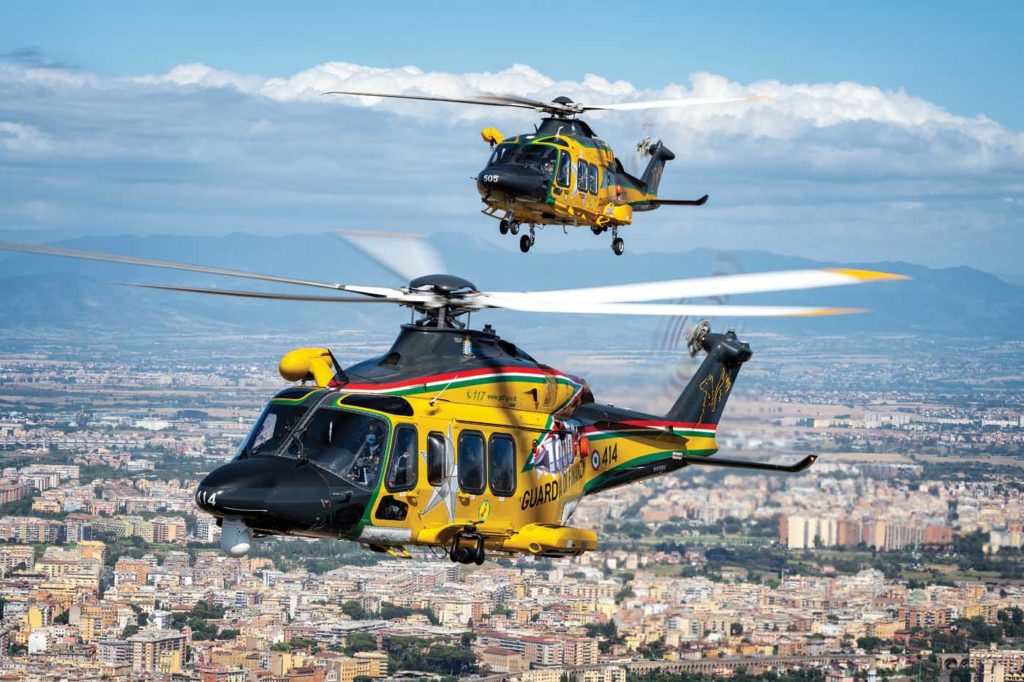
While these new aircraft might be alike, the AW169 in particular is a generation ahead of the machines it is joining on operations, and which it will likely eventually usurp. Santagati explained that the equipment on board brought new capabilities in particular roles.
“We do conduct [search-and-rescue] over the sea, but we have specific SAR duties over land, particularly in the mountains,” he said. “We have two units that cooperate with colleagues in the mountain rescue services and we now have a special system in the 169 that allows us to search for mobile phones.”
While still not commonplace, this equipment is becoming more widely used in SAR aircraft, as it can detect, identify and geolocate a cell phone without the owner’s input. Potential applications in the Guardia di Finanza’s law enforcement role do not demand a great deal of imagination.
Another advantage over the new aircraft’s older stablemates is flexibility.
“They are multi-role aircraft,” explained Santagati. “The main task is to patrol over the sea, but the equipment can be changed in a few minutes, or maybe an hour, to perform a different task.”
Alongside their role at sea, Pascale explained that aircraft assigned to the Gruppi Aeronavale could also be tasked with operations over the interior, with some even being used to support other branches of law enforcement.
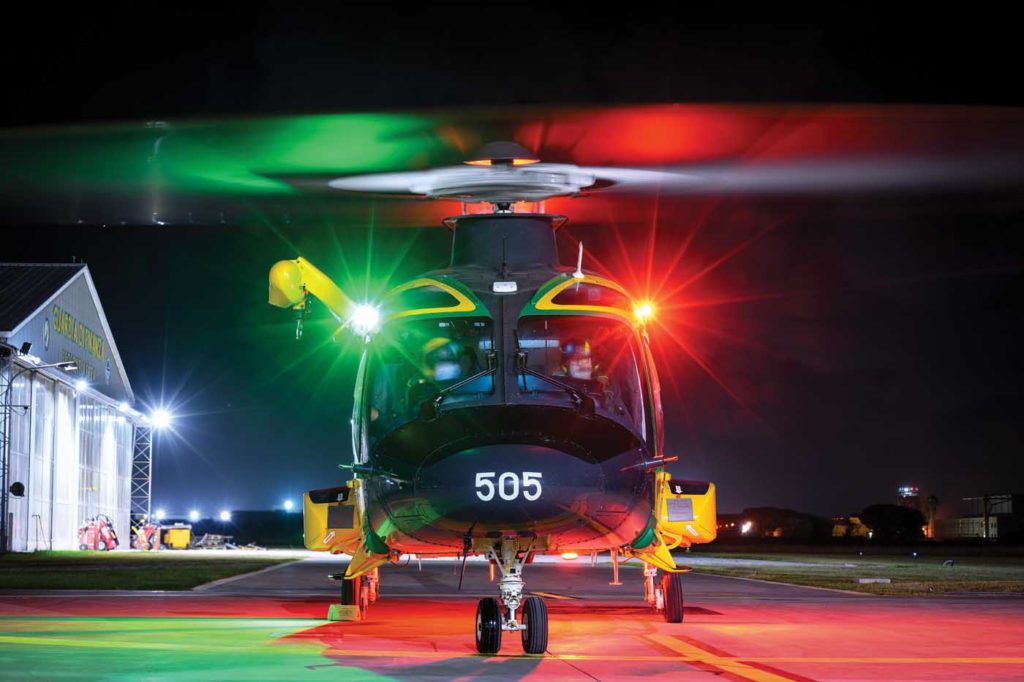
“They usually perform flights in close collaboration with patrol vessels and with specific targets, but they are also used to support the territorial departments which are not strictly connected with the Aeronavale operating command,” he said. “For example, against organized crime, where it is important to secure airspace above a ground operation.”
Santagati explained that patrols are crewed depending on the task.
For a patrol, usually we have only two pilots and a system operator, because this allows more fuel and more endurance,” he said. “Sometimes we also have a technician on board, especially if we have to perform more than one flight or refuel at another airport. For search-and-rescue missions we also are able to carry a hoist operator.”
All-weather able
Each system operator presides over a mission system that controls and draws data from a variety of sensors similar to those fitted on both the ATR-42MP and ATR-72MP long-range fixed-wing maritime patrol aircraft.
“With the new helicopters we have a mission system operated by an MSO and the crew is able to patrol and track targets in any weather without being detected,” said Santagati. “We have some very high-performance sensors which allow the system operator to track a number of targets at the same time.”
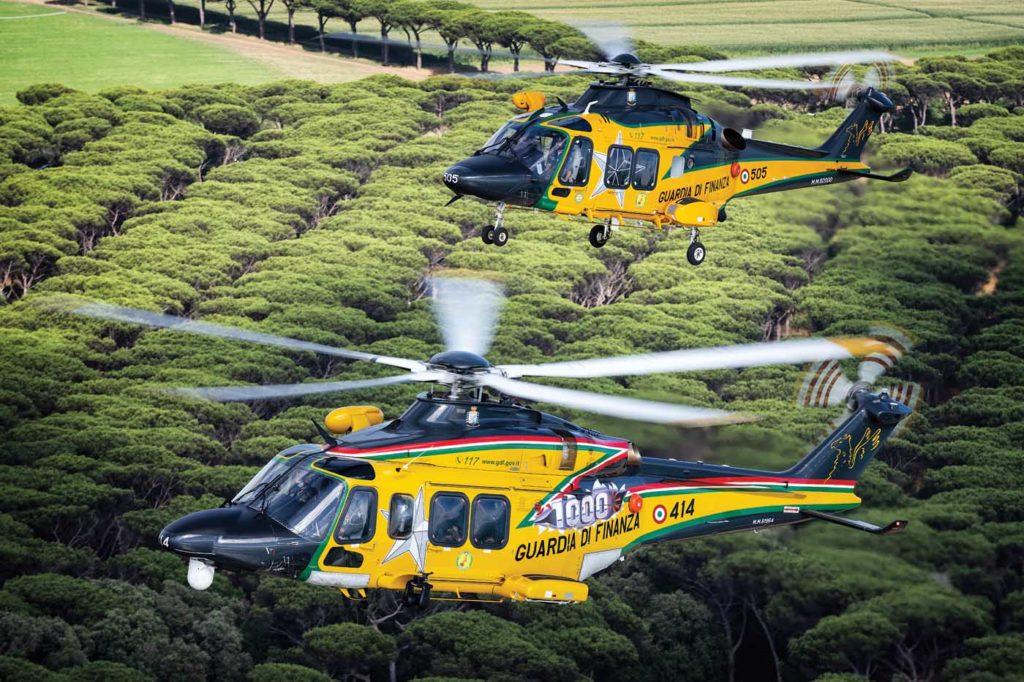
Perhaps more important than the number of targets, is the fusing and exchange of data between assets that the mission system allows. System operators on board the fixed-wing patrol aircraft can search huge areas of sea for contacts of interest, with the mission system allowing easy handover of target locations to the helicopters.
Surprise is an essential element of many law enforcement activities, particularly in anti-smuggling operations. Easy coordination with fixed-wing aircraft allows the helicopter to detect the target without needing to cover a large search area itself, potentially revealing its position, and long-range sensors mean that targets can be tracked, and evidence collected, long before the aircraft can be seen by the target.
“With these sensors we can fly in any conditions, day or night, and still track all the targets we are given,” said Santagati, smiling. “We say we are like ghosts.”
But target detection is only half the battle. In the 21st century, smugglers and other villains of the high seas tend not to sail around flying the Jolly Roger, but instead will modify ships’ transponders or even repaint their vessel at sea in an attempt to evade detection.
International effort
Discriminating the law-abiding seafarers from modern organized criminal activity depends not on the range of your radar but the range at which you are able to gather meaningful intelligence, a process that often extends beyond Italy’s territorial limit.
While its fixed-wing maritime patrol aircraft are capable of gathering intelligence far out over international waters, the Guardia di Finanza also deploys its airplanes and helicopters to other European countries to cooperate with law enforcement activities there. This not only helps deal with the problem at its source, but also provides intelligence that aids their own search efforts at sea.
Operations in Albania and Macedonia are aimed at the marijuana smuggling industry, while cooperation with Spain has helped stem the flow of cocaine. Since 2018 alone, the Guardia di Finanza has been at the center of operations that discovered 20 tons of hashish in the fuel tanks of a cargo ship, over $500 million worth of cocaine aboard a ship in Genoa, and in 2021 a world record haul of $1.1 billion worth of a drug called Captagon, thought to have been manufactured by the Islamic State group to fund terrorism.
“This year we are taking part in two new operations in Albania and Montenegro with two helicopters deployed to patrol the coastline there,” Pascale said. “In Spain, we usually send fixed-wing assets such as our ATR-72, and we perform an assigned number of patrolling hours there.”
Many of these international collaborations are conducted within the framework of Frontex, charged with coordinating the security of Europe’s external borders. Established in 2004 as a means of coordinating border control efforts, its mandate was extended in response to the 2015-2016 migrant crisis in Europe, to make it an official Border and Coast Guard Agency.
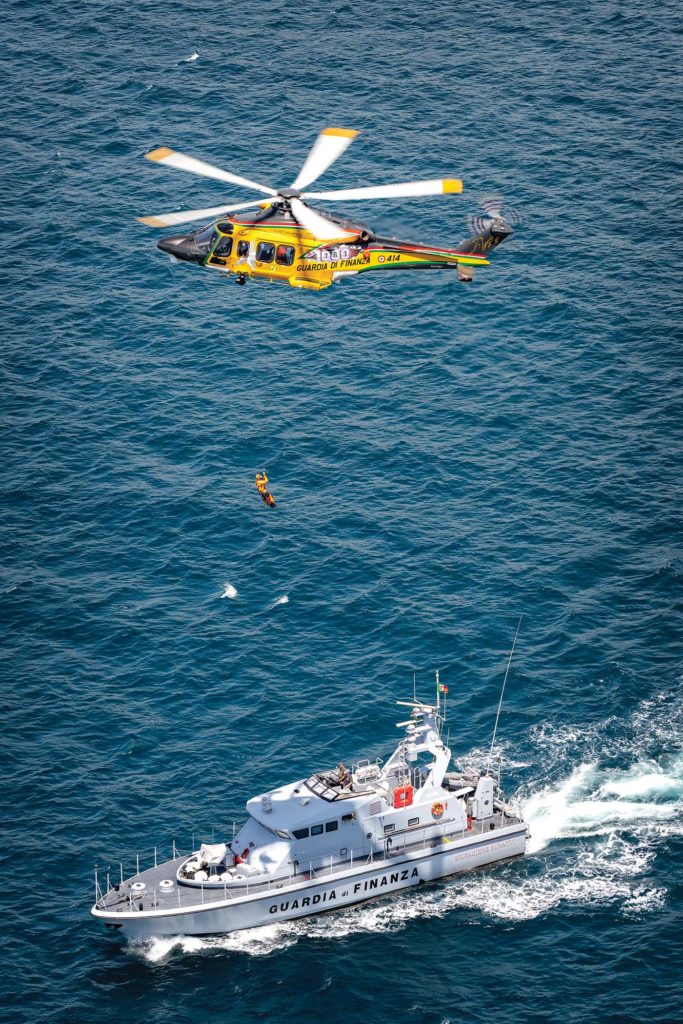
The Guardia di Finanza is fundamentally integrated into Frontex, with the International Coordination Centre (ICC) located within the COAN headquarters. This ICC coordinates activity across a network of local coordination centers and with ICCs in other nations. This allows the resources of several states to be closely coordinated or brought to bear extremely quickly in response to new intelligence.
“The ICCs acquire information from Frontex headquarters in Warsaw and all of the aerial and naval assets under Frontex,” Pascale said. “The ICC has several national officials from other European countries who can assign their own assets to tasks, and the Guardia di Finanza is also deployed in other countries under the authority of Frontex, so it is a fruitful exchange for us.”
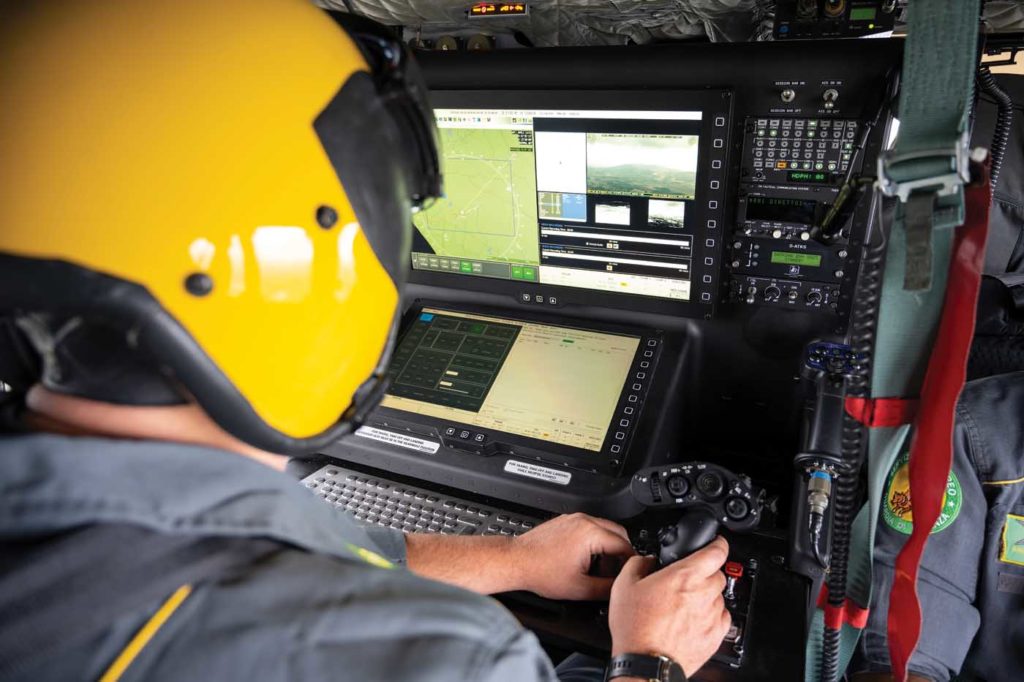
With its original focus having been on controlling the illegal movement of people into Europe, Frontex has not been without controversy. There are important legal distinctions between trafficked and smuggled people which are not easy to discern from the air, particularly when they are in an unseaworthy craft that de-facto places them in the position of being “in distress.”
With criminal organizations more than willing to exploit instability in other countries, being able to conduct both surveillance and rescue in the same mission is now sadly a necessity in the Mediterranean.
Santagati has experienced both sides of that coin and considers his time training Frontex crews a career highlight.
“When I was working with Frontex and the other European border agencies there was a great exchange of experience between my colleagues,” he said. “But I’ve now been working in training for 20 years, so this is the field where I have the most experience, and hopefully the most success.”
However, Santagati believes it is the rescues which provide the biggest challenge to the crews that he helps train.

“SAR missions are very challenging,” he said. “When crews are hoisting a survivor, all crewmembers really realize how good their training is. Because in that moment everybody has to give more than 100 percent of their performance.”





